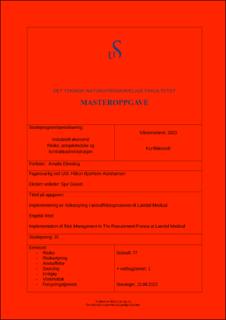| dc.description.abstract | In recent years, the societal landscape has been marked by increased uncertainty, such as the covid pandemic, wars, economic instabilities, and other events that affect Laerdal Medical's procurement process. With a rise in risk factors associated with procurement, it is advisable to enhance the degree of manageable risk to be well-equipped for known and unknown risk factors that may arise in the future.
The purpose of this master's thesis has been to investigate how the current procurement processes at Laerdal function and how the implementation of risk management can increase the degree of manageable risk in the procurement process. To address the research question, a qualitative research method has been employed, where the empirical findings have been obtained through five structured interviews and one semi-structured interview. Based on the existing processes, the results from qualitative research and literature review primarily related to risk, the research has also identified the risk factors faced by Laerdal.
The findings of the research indicate that the procurement processes, as they currently stand, follow a general management process where the implementation capability is not sufficient for all cases. The form of risk management in the procurement process is based on methods, processes, and strategies. The study's findings suggest that actions have been implemented for some parts of the procurement process to handle the changes in the societal landscape, in addition to the existing processes. The thesis reveals that risks related to purchasing and goods receipt are relatively short-term when it comes to production stoppages, while risks associated with sourcing and supplier performance management can pose long-lasting and resource-intensive challenges.
The study concludes that the execution capability of current processes must be strengthened to increase the degree of manageable risk. Risk management must also be implemented through insight into risk relationships. This can be achieved by distinguishing between known and unknown risk factors and mapping the risk factors that will affect the procurement process. The findings of the study suggest that a more risk-conscious culture must be fostered in the workplace, where leaders must motivate and facilitate the development of a risk culture to a greater extent. The effect of implementing risk management will thus lead to Laerdal being prepared to detect events before they become critical and achieve an increased degree of manageable risk in the procurement process. Finally, it would be appropriate to consider the costs associated with the implementation, which this study has not considered. | |
